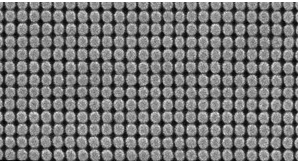A*STAR Reveals Operational Parameters for HAMR
To understand thermo-magnetic reversal process and recording performance
This is a Press Release edited by StorageNewsletter.com on April 8, 2015 at 3:08 pmThe mechanics and dynamics of heat-assisted magnetic recording (HAMR) are now better understood thanks to work by A*STAR and the National University of Singapore.
A scanning electron micrograph of an array of 50-nm-diameter
magnetic islands used to simulate HAMR storage medium
(Credit: AIP Publishing LLC)
The experimental study will help scientists aiming to break the areal density barrier of current magnetic HDD technology.
Today’s HDD drives record and store data in minute magnetic domains on a spinning magnetic platter. As the magnetic domains become smaller, the thermal noise rises rapidly, making it increasingly difficult to record data reliably. HAMR (Heat-Assisted Magnetic Recording ) is a promising future storage scheme that uses a more stable magnetic medium, in combination with local heating, to achieve more reliable magnetization switching.
“HAMR can be implemented with magnetic grains as small as 3 nm and higher magnetic anisotropy, which will make it possible to store magnetic information at recording densities beyond a terabyte per square inch,” says Yunjie Chen, research leader, A*STAR’s Storage Institute.
Theoretical simulations have demonstrated the potential of HAMR but also the possibility of density-limiting electrical noise and problematic non-reversal of magnetic domains in the recording process. Chen’s team designed some experiments to probe the dynamics of HAMR.
“For practical application of HAMR, it is important to understand the thermo-magnetic reversal process and recording performance, including magnetization dynamics and effects that limit areal density,” says Chen.
The experimental HAMR recording system devised by Chen’s team consisted of an array of magnetic islands of multilayer cobalt and palladium. Preparing this device involved sputtering multiple atomic layers of different combinations of elements, then patterning the device using electron-beam lithography to produce magnetic islands of about 50nm in size. The team then used far-field laser heating with a thermal spot size of about 1.5 micrometers in combination with a magnetic field to simulate the magnetization switching of the HAMR process. They observed the resultant magnetization patterns using a high-resolution magnetic force microscope.
Chen’s team showed that when the material was laser heated to near its Curie temperature-the temperature at which the material’s permanent magnetism is overcome by an external magnetic field-the strength of the magnetic field required to induce complete magnetic switching was about 13% of the intrinsic magnetic ‘coercivity’ of the islands. Surprisingly, however, the team also discovered that, due to thermal fluctuations, the optimal temperature for recording is slightly lower than the Curie temperature.
Chen explains that the results provide critical operational parameters for the practical implementation of HAMR storage technology
Explore further: Technology helps improve production of laser-heated HDD drives with enhanced storage capacities
More information: Chen, Y. J., Yang, H. Z., Leong, S. H., Wu, B. L., Asbahi, M. et al. A study on dynamic heat assisted magnetization reversal mechanisms under insufficient reversal field conditions. Applied Physics Letters 105, 162402 (2014). dx.doi.org/10.1063/1.4899135















 Subscribe to our free daily newsletter
Subscribe to our free daily newsletter


